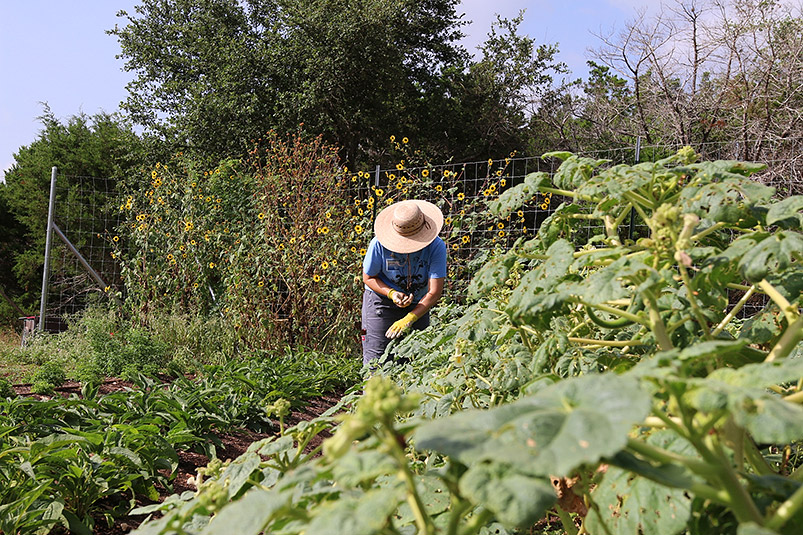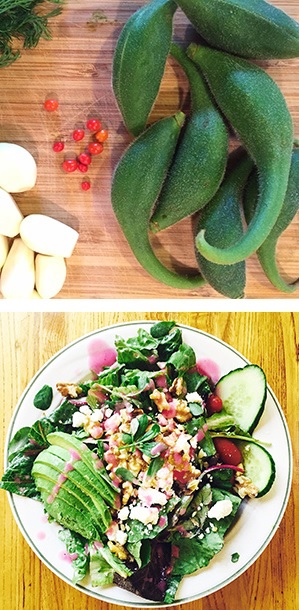Find Your Roots (and Eat Them!)

Intern Rosalie Kelley inspects a row of devil’s claw (Proboscidea louisianica) in the Taste of Place garden; to her right, purple coneflower (Echinacea purpurea) awaits a future as herbal tea. Common sunflower (Helianthus annuus) blooms behind her. PHOTO Amy McCullough
Think about what gives you a sense of “place” where you live. Is it the silhouettes of particular tree-dotted hills on the horizon? How about the morning chatter of neighborhood jays and wrens? Perhaps it’s a constant sea breeze (lucky you) or the sweet smell of Texas mountain laurel in a nearby park. Though all the senses can transport us, some of the most celebrated and shared experiences grounding us culturally and geographically are based on taste. With that in mind, the budding Taste of Place project at the Wildflower Center aims to put more native seeds in the ground and native plants (grown and foraged) on the plates of Central Texans.
Focused on growing, harvesting and preparing native edible plants, Taste of Place is a collaboration between the Wildflower Center and The University of Texas at Austin Green Corps (part of the Division of Housing and Food Service). The project aims to start a dialogue among students in various fields, such as landscape architecture, urban planning, sustainability and nutrition, about what it means to eat locally. Native plants support healthy landscapes in that they require less water and fewer pesticides and fertilizers than are typically used in non-native gardening. Edible native plants are no different: They can be drought-tolerant and disease-resistant and need less tending. Most are perennials or self-seeding annuals, requiring a single planting for multiple harvests — a return on investment a gardener can really get behind.
With leadership from the Center’s Andrea DeLong-Amaya and Danielle Pieranunzi — director of horticulture and SITES® director, respectively — volunteers and interns are populating a roughly 3,000-square-foot garden with rows and patches of native edibles. The plants (see below) are being harvested and prepared in dishes and teas. The first Taste of Place culinary creations have been easy to prepare and well received. Pieranunzi’s pickled devil’s claw (Proboscidea louisanaca) elicited many “Mmmms” at a recent tasting, and the Wildflower Café served a colorful summer salad (pictured below) featuring purslane (Portulaca oleracea) — the nativity of which is uncertain — and a dressing made from the fruit, or tuna, of Texas prickly pears (Opuntia engelmannii var. lindheimeri).
One morning, interns offered small cups of caffeinated tea made from yaupon leaves (Ilex vomitoria) to Center employees (the flavor is similar to that of yerba mate, the popular South American drink made from another holly, Ilex paraguariensis). Having passed the initial taste test, it was then served to the public during one of the Center’s educational Nature Nights in June. Stir-fries, jams, sauces and sandwiches are all on the docket for the fruits of future harvests and foraging excursions.
While wild foraging will largely occur at the Center, some generous local landowners have offered up their grounds to the Taste of Place team’s foraging forays, as well. DeLong-Amaya says she expects to find mustang grape (Vitis mustangensis), Texas persimmon (Diospyros texana), prairie tea (Croton monanthogynus) and yaupon. Foraging and focusing on natives allow for the type of freshness and spontaneity savored by chefs who prefer to work with the flavors of the seasons (for an Austin-based example, see our story on Chef Jesse Griffiths). Taste of Place also underscores the idea that people can really connect with place through their taste buds.
Presently funded by a grant from the Green Fee Program, the Wildflower Center hopes to generate interest and raise funds to continue to provide edible native tours, educational talks and activities, and community engagement events. “We really think there’s an opportunity, especially here in Austin, to get people to learn and care about native plants by appealing to their interest in local food,” says Pieranunzi. “We talk about the benefits of native plants to healthy landscapes and wildlife habitat; this is just one more way we can appreciate their unique contribution to human health and to our sense of place.”

Devil’s claw (top), salad featuring purslane (bottom)
Place on Your Plate
Chile pequin – Hot chilies, dry or serve fresh
Common sunflower – Use seeds in breading and salads or eat straight as a snack
Devil’s claw – Pickle, use in stir-fries and curries (similar to okra)
Dewberry – Use like blackberries in cobbler, jam
Mealy blue sage – Use dried leaves to make herbal tea
Pink evening primrose – Use leaves fresh in salads and on sandwiches
Purple coneflower – Use in medicinal tinctures or herbal tea
Purslane – Pickle; use in soups, salads and omelets
Wild onion – Use like chives or onions
Winecup – Edible tubers, use like sweet potatoes Be sure to positively identify any plant before consuming.
Related Stories:
Taste of Place Project Info
Native Plant Recipes:
Chile Pequin-Citrus Turkey
Vegan Wild Onion and Tuber Stew
Wild Onion and Chile Pequin Cornbread

